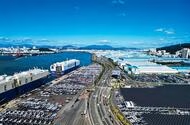Hyundai’s Ulsan Plant: A Marvel of Modern Manufacturing
Imagine standing on the bridge of a massive cargo ship, the Morning Christina, as it prepares to set sail across the Pacific. Below, thousands of gleaming Hyundai cars await their journey to California, packed tightly on the ship’s 11 decks. This scene unfolds at Hyundai’s Ulsan plant, the largest car manufacturing facility in the world, where innovation meets efficiency in a breathtaking display of modern industry.
How Does Ulsan Achieve Such Incredible Production Numbers?
The Ulsan plant is nothing short of a manufacturing powerhouse, churning out an astonishing 1.5 million vehicles each year. To put that into perspective, that’s almost double the total output of all 25 factories in the UK combined for 2024. This facility is so efficient that it could have satisfied 98% of all new car sales in Italy last year alone. The secret? A unique integration of production and logistics, with an on-site port that allows for seamless shipping to over 200 countries.
Spanning a sprawling 1,200 acres—about the size of a small town—the Ulsan plant houses five factories and an engine and transmission plant. Each day, production lines run for 18 hours, producing a diverse lineup of 17 different models, including popular vehicles like the Hyundai Santa Fe and Tucson, as well as the luxurious Genesis series. And it’s not just about volume; a sixth plant dedicated to electric vehicles is set to open next year, signaling Hyundai’s commitment to the future of automotive technology.
What’s the History Behind This Gigantic Facility?
The Ulsan plant’s story began in 1968, just a year after Hyundai was founded. Initially, it served as a modest assembly facility for Ford, where Cortinas were hand-built for the local market. Fast forward to today, and the site has transformed into a colossal manufacturing hub. As you drive through the grounds, you’ll see factory after factory, interspersed with lush greenery—around 600,000 trees, to be exact.
One of the most fascinating aspects of the Ulsan plant is its evolution. Plant 5, built in 1979, originally produced golf carts by hand. Now, it’s home to the production of high-end Genesis models and innovative hydrogen-fueled vehicles like the Hyundai Nexo. This shift reflects not only Hyundai’s growth but also its adaptability in a rapidly changing automotive landscape.
How Does the Shipping Process Work?
Once vehicles roll off the production line, they undergo rigorous quality checks before being transported to the dockside car park. From there, they are loaded onto massive roll-on/roll-off vessels, like the Eukor, which departs every 24 hours. This efficient shipping method saves both time and money, enabling Hyundai to maintain its impressive production rates. The logistics of this operation are a key factor in the company’s ability to deliver vehicles globally, ensuring that fresh cars are always on the move.
What Impact Has Hyundai Had on Ulsan?
The city of Ulsan has grown exponentially alongside the plant, now boasting a population of 1.1 million—roughly equivalent to Birmingham. When the factory opened, only 30,000 people lived in the area, a stark contrast to the 34,000 employees it now supports. Once a simple fishing port, Ulsan has transformed into South Korea’s industrial heart, home to Hyundai Heavy Industries, the world’s largest shipbuilding company, and a major oil refinery.
Hyundai’s influence is palpable throughout the city. From highways named after the company’s founder to institutions bearing the Hyundai name, the brand has woven itself into the very fabric of Ulsan. This symbiotic relationship highlights how the plant has not only shaped the company but also the community around it.
The big takeaway? Hyundai’s Ulsan plant isn’t just a factory; it’s a testament to ambition and innovation in the automotive industry. With its unique integration of manufacturing and logistics, the plant has redefined what’s possible in car production. If you’re looking for a glimpse into the future of manufacturing, Ulsan is where you’ll find it. Start thinking about how such efficiency and innovation could inspire changes in your own industry or endeavors.

